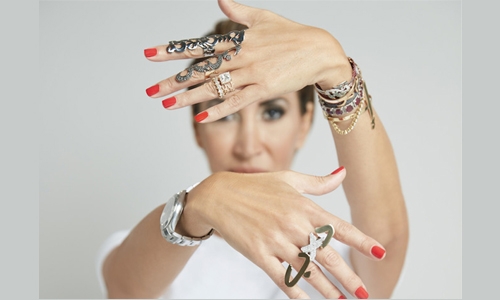Lebanese designer’s language of love
Can a piece of jewellery express a love of one’s language? “Of course,” says Lebanese photographer, jewellery designer and entrepreneur Nadine Kanso. “That is the main inspiration behind my jewellery line.” Kanso is talking about her Bil Arabi (‘In Arabic’) brand. “It is all based on the beauty of Arabic calligraphy, language, and letters,” she explains. “The Arabic language represents my identity, my pride, and, obviously, the history of what Arabs have contributed to the world.”
Kanso was born and educated in Beirut but established her award-winning brand in Dubai over a decade ago. However, before Kanso’s pursuit of sophisticated jewellery design, it was photography that initially captured her artistically inclined mind during her years as a communication arts and advertising design student in the late 1990s. Her work was primarily inspired by the contemporary landscapes and contradicting social scenery of Beirut. Kanso got her first big break in 2006, when London’s Victoria and Albert Museum invited her to showcase her photography as part of a group show, entitled “Arabize Me.”
Kanso photographed people from different Arab countries holding cards she had inscribed with gold calligraphy, containing statements including “Talk to me,” and “My love is Arabic.” The idea, she has said, was “to explore contemporary Arab identity and narrative.” That same year, Kanso launched Bil Arabi, and has since garnered a diverse clientele across the Gulf region and beyond. Kanso was one of the first Dubai-based artists to present Arabic lettering through thoughtfully designed and customized jewellery.
Bil Arabi is a unisex line, and consists of colourful collections of 18-karat gold rings, necklaces, earrings, cufflinks, and bracelets. Kanso’s design aesthetic has evolved over the years — from her popular oversized ‘Noon’ or ‘N’ rings to star-shaped, enamelled jewellery that reveals a bedazzling repetition of separate letters (as part of the “Nujum” collection), and even eye-catching finger-length ‘toul’ rings, which stack a mesh of Arabic letters horizontally. Kanso’s design vocabulary is dominated by positive words like “Al Hob” (love), “Al Hayat” (life), and “Al Noor” (light), and she frequently incorporates her own handwriting, giving a distinctive personal touch to a piece.
Bil Arabi has proved popular with consumers and brands alike. In 2016, Kanso collaborated with Emirates Airlines on a line of notepads, plates and mugs which she embellished in her own handwriting with the Arabic term “Al Emarat,” in gold lettering. Last year, in Dubai Design District, Kanso unveiled her collaboration with Lebanese carpet gallery Iwan Maktabi — a wall-mounted rug that bears the image of the UAE’s founding father Sheikh Zayed bin Sultan Al Nahyan. Kanso’s unique touch is a repetition of the phrase “Zayed El Kheir,” a tribute to the sheikh in the Emirates’ ‘Year of Zayed.’
Aside from the aesthetics of her bold jewellery pieces, there is an underlying element of symbolism and conceptualism to Kanso’s work. The aim of Bil Arabi is, essentially, to celebrate Arab culture and heritage — and to fight misconceptions about the Arab world. Post 9/11, Kanso says, “I felt that Arab identity became subdued and the Arabic language had a negative connotation; people were even afraid to give their children Arabic names. That was one of the main triggers that got me working on my body of work, both in photography and jewellery design.
Artists and designers have a certain (way) of writing history and giving people another way of observing the region,” Kanso said. In the end, Kanso hopes Arabs will feel a sense of pride from wearing her jewellery. “People need to be proud of their language, history and heritage,” she says. “I’m very happy to see people actually engaging with the brand and feeling proud when wearing a Bil Arabi piece — it’s definitely the biggest compliment.”
Related Posts

